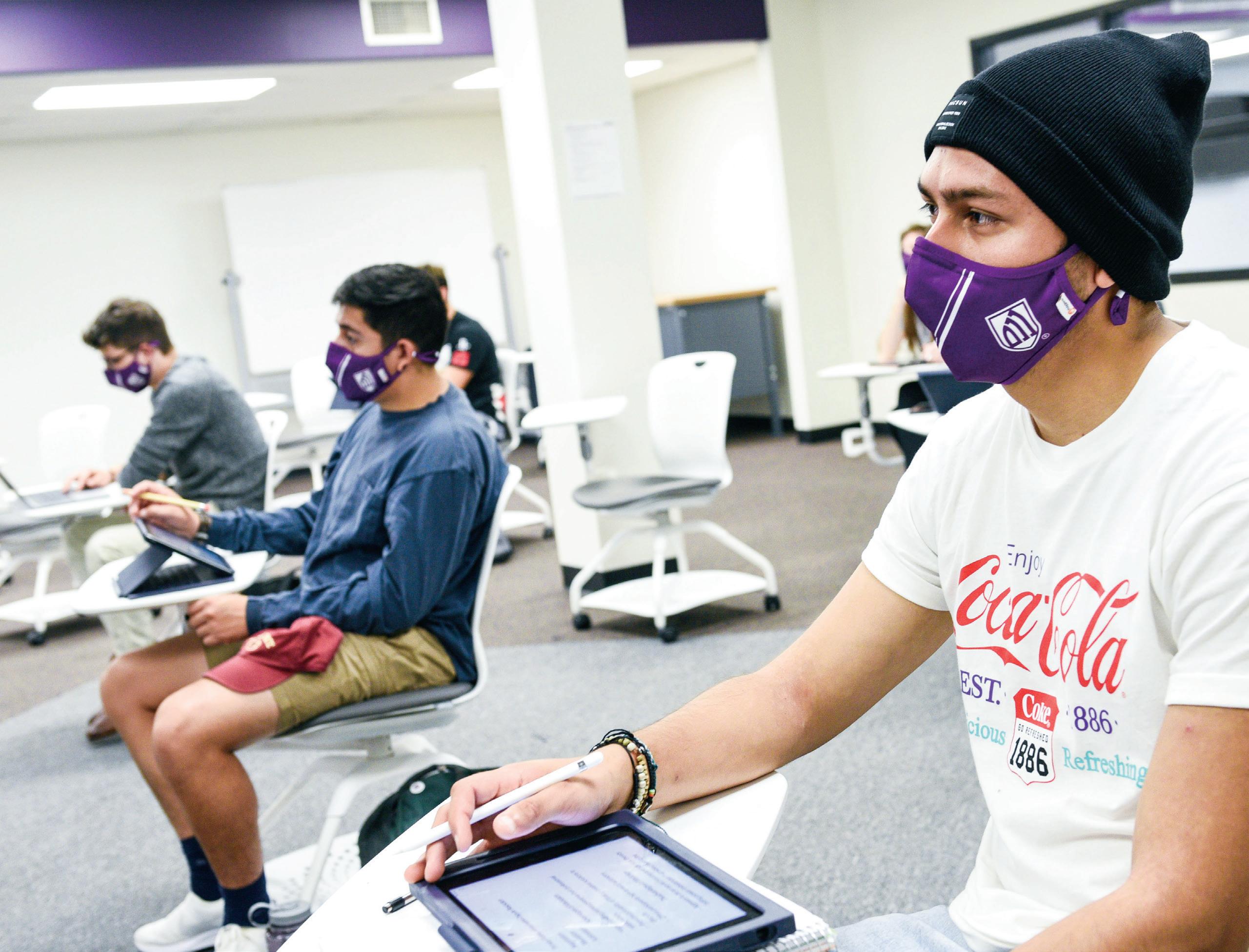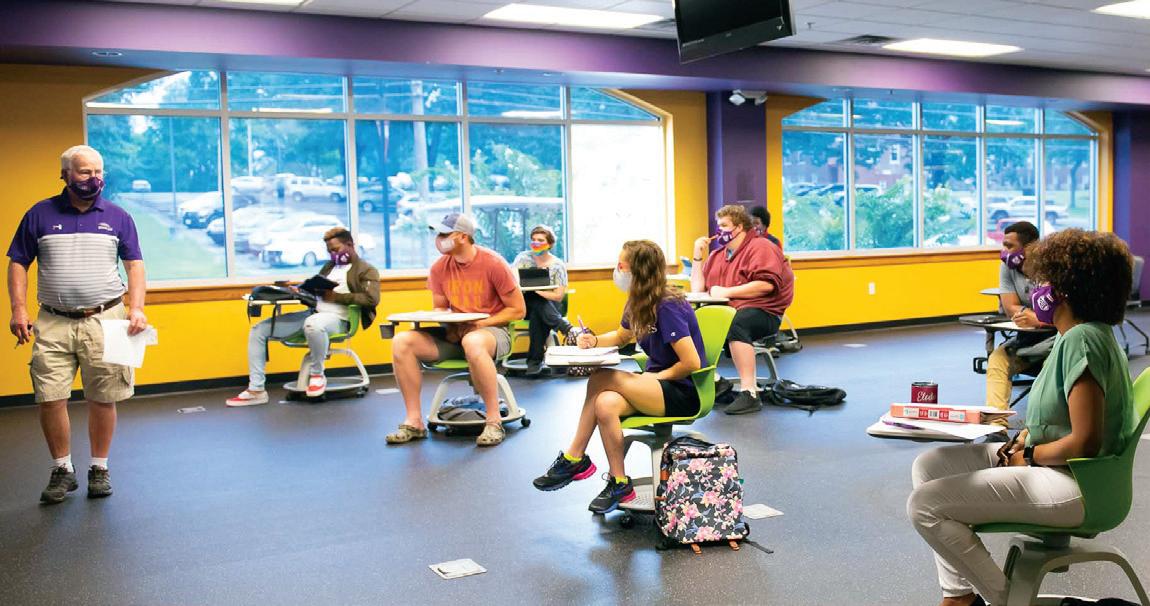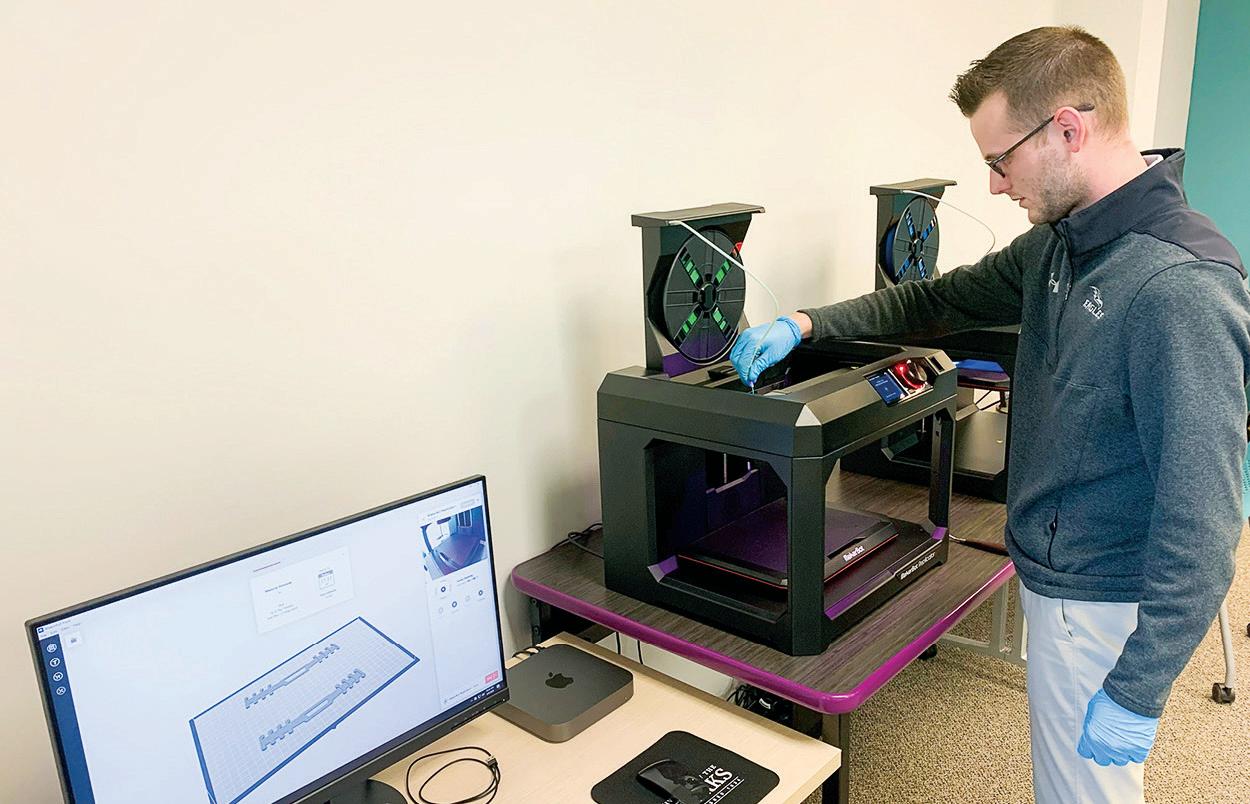
7 minute read
Climate of Covid
THRIVING IN THE
Age of Covid
Advertisement
When University of the Ozarks opened the 2019-2020 academic year with a Walton Arts & Ideas Series event titled, “Facing Adversity with Optimism and Resilience,” little did the campus community know how appropriate that message would become.
The WAIS speaker was J.R. Martinez, an actor, best-selling author, motivational speaker, and wounded U.S. Army veteran, who spoke on campus in August 2019 about his life experiences in recovering and thriving after being severely injured from a roadside bomb in Iraq.
“None of us knows what we’re capable of until we’re faced with a tough or unexpected challenge,” Martinez said. “Often this means having to adjust your dream or vision and sometimes even to create an entirely new goal. It can also mean getting through a tough time a week, day, hour or even minute at a time. By focusing on shorter term goals and keeping optimism, and even humor, at the forefront, your entire outlook and perspective can be transformed. We are all stronger and more resilient than we think. In facing challenges and recovering from setbacks, we have new opportunities to develop the unique gifts that have been given to us. It’s about being able to become more than what you can envision at the moment.”
In a short seven months after hearing that message, the Ozarks community was put to the ultimate challenge with the Covid-19 pandemic. The virus forced the University to transition to an all-online teaching and learning format in late March and led to the cancellation of numerous campus events, including the Spring 2020 Commencement ceremony.
University President Richard Dunsworth credited what he called Ozarks’ “frontier grit” in helping the University navigate the unprecedented times of the pandemic.
We remind people what it might have been like on the frontier when Ozarks was established,” Dunsworth said. “There were times on that frontier where it got very difficult and challenging, and that’s when people stepped up and made things happen. This University has 186 years of surviving and thriving through difficult times, so we know how to handle this.”
Dunsworth said he was impressed with his faculty and staff and students in the transition from in-person classes to an all-online format last March following spring break.
“When we learned there was going to be a problem, it took approximately 10 days to completely flip the way we deliver classes,” he said. “We took an extended spring break of 10 days

The Rawhouser Fitness Center was one of the facilities that was repurposed into a classroom to allow for physical distancing.
and on that next Monday we were up and running. Technology is a big part of that, infrastructure is a part of that and people’s determination to not quit and give up. We have also gotten great support from our alumni and friends as well as foundations that have allowed us to have this technology in place.”
Dunsworth said when the pandemic hit that the first priority was in protecting the jobs of the faculty and staff.
“We publically stated to our faculty and staff that we were committed to them and we let them know they would have a job,” Dunsworth said. “If our faculty and staff are worried about losing their jobs or being furloughed, they aren’t going to be 100 percent focused on our students, so we eliminated that concern right up front. I think that was a big key in making the transition work.”
The University not only took steps in providing credit adjustments to students who moved off campus, they allowed approximately 100 mostly international students who couldn’t go home to remain on campus throughout the summer.
The University also put together a task force for the repopulation of campus over the summer. The task force was led by Gloria Arcia, vice president of finance and administration.
“Our main focus was in three areas,” Arcia said of the task force. “First, in every decision our focus was on the health and wellbeing of students, faculty, staff and visitors. Second, we were committed to maintaining the University’s high standard of excellence in all forms of academic instruction and activities. Third, we were committed to being flexible and innovative in the face of evolving circumstances.”
Arcia’s team put together the extensive plan to reopen campus for the fall semester that included everything from repurposing facilities on campus for larger classroom spaces, to designating quarantine housing for students who test positive, to creating a contact tracing system for the campus community.
“One of the greatest strengths of our University is the togetherness and supportive community that we have all come to rely on,” Arcia said. “We would not have been able to accomplish this monumental task of reopening campus without the help and support of everyone on campus. There were many unique and serious challenges, but through our collective spirit and teamwork we were able to work through these challenges and make a successful transition back to campus.” Classes
Innovation Hub Joins Fight Against Covid-19
The University untilized its new Innovation Hub to help provide relief to local healthcare workers in the fight against the COVID-19 pandemic.
Ethan Hefley, information technology network manager, led the University’s efforts in producing ear guards for masks on four 3-D printers in the Innovation Hub, established last year.
The ear guards help healthcare workers who experience discomfort from extended use of protective masks. The ear guards were designed by Quinn Callander, a 12-year-old Canadian boy scout who was searching for a simple but effective device that would prevent the elastic bands on a mask from rubbing against the backs of people’s ears.
Callander’s design, a wide plastic strap that goes around the back of the head, has notches so the wearer can loop the mask’s elastic straps around whichever notches are most comfortable, allowing them to adjust the tension while keeping the mask firmly in place. He made the design available for others to download from the open-source 3D printing community Thingiverse.
Hefley said he printed about 200 ear guards during the summer and distributed them to healthcare providers in Clarksville.
“I was looking for a way that we could utilize our 3-D printers in this effort to fight the coronavirus and I looked into masks, but that just wasn’t going to work,” Hefley said. “My wife saw (Callander’s) prototype on the internet and brought it to my attention. I felt like this would be a perfect way to utilize the 3-D printers to assist our healthcare workers.”
Hefley said the four 3-D printers have the capability to produce a combined 20 ear guards every two and a half hours at a cost of about 35 cents each in material, a corn plastic filament.
Hefley delivered ear guards to the Clarksville Medical Group, much to the delight of administrator Jeri Williams and the staff.
“These ear guards will help tremendously for the nurses who are having to wear masks all day long on a daily basis,” Williams said. “Our personnel have no choice but to wear masks right now at all times and the constant rubbing has become a real problem. The ear guards are the perfect solution. We are extremely excited and appreciative to get these.”




